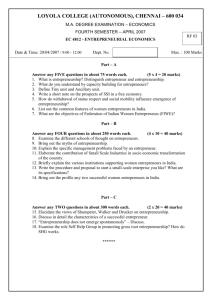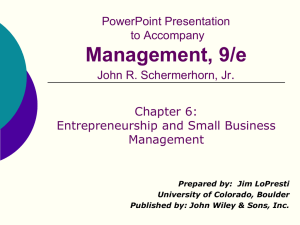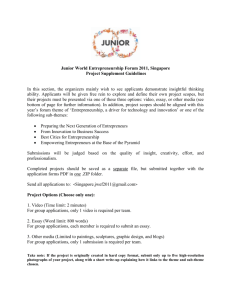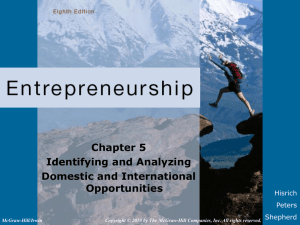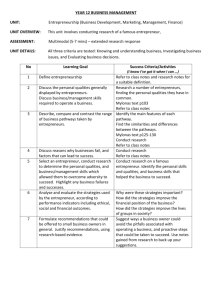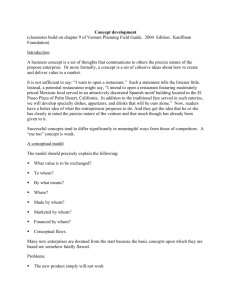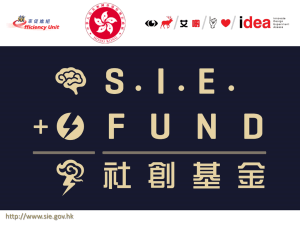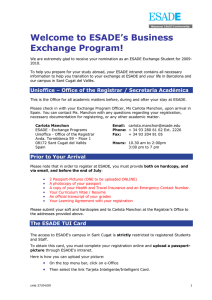master programme in innovative hospitality management
advertisement
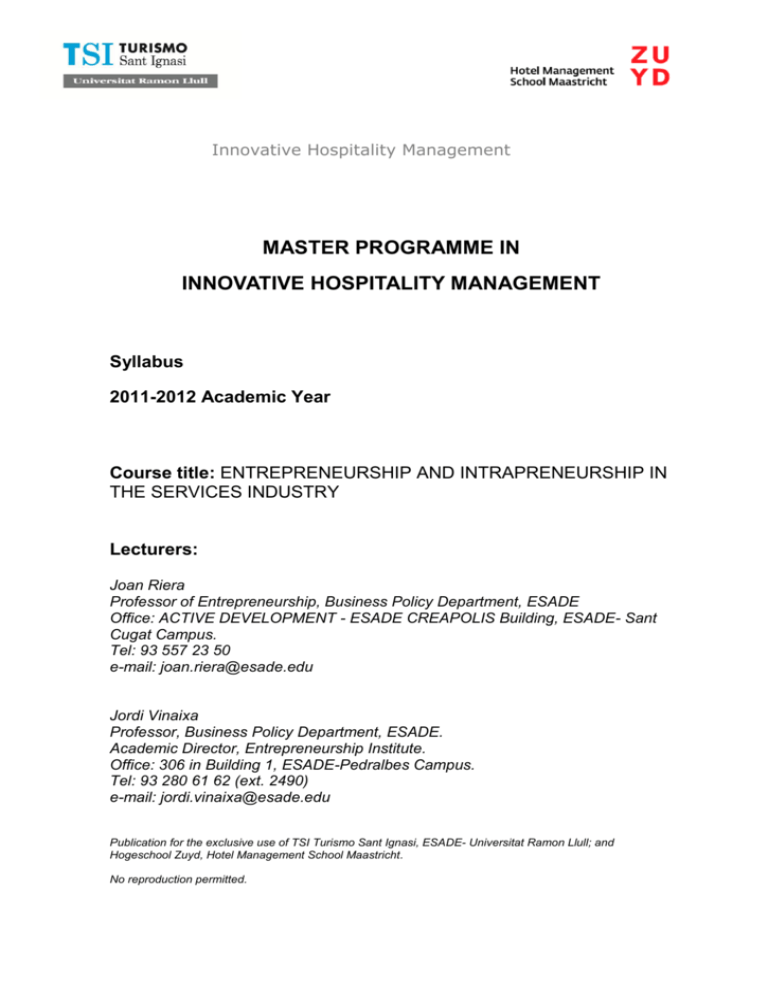
Innovative Hospitality Management MASTER PROGRAMME IN INNOVATIVE HOSPITALITY MANAGEMENT Syllabus 2011-2012 Academic Year Course title: ENTREPRENEURSHIP AND INTRAPRENEURSHIP IN THE SERVICES INDUSTRY Lecturers: Joan Riera Professor of Entrepreneurship, Business Policy Department, ESADE Office: ACTIVE DEVELOPMENT - ESADE CREAPOLIS Building, ESADE- Sant Cugat Campus. Tel: 93 557 23 50 e-mail: joan.riera@esade.edu Jordi Vinaixa Professor, Business Policy Department, ESADE. Academic Director, Entrepreneurship Institute. Office: 306 in Building 1, ESADE-Pedralbes Campus. Tel: 93 280 61 62 (ext. 2490) e-mail: jordi.vinaixa@esade.edu Publication for the exclusive use of TSI Turismo Sant Ignasi, ESADE- Universitat Ramon Llull; and Hogeschool Zuyd, Hotel Management School Maastricht. No reproduction permitted. Innovative Hospitality Management MASTER PROGRAMME – COURSE SYLLABUS COURSE: Entrepreneurship and Intrapreneurship in the Services Industry CODE: B2 EIS COURSE TYPE: Compulsory ECS CREDITS: 5 LECTURER/S: Joan Riera, Jordi Vinaixa YEAR: 2011 - 2012 BLOCK: Barcelona 1. General description of the course. The dynamics of business have changed fundamentally. Technological advances, global interconnectedness, and societal changes among other factors create a new setting for businesses. Large corporations experience hyper-competition and limits to growth due to saturated markets for their traditional products. Markets converge or differentiate into ultra-niche markets. The classical economics of capital and scale have turned into economics of ideas and networks while the speed of innovation and change increases. More than ever vast opportunities arise for aspiring entrepreneurs. This course aims to inspire and empower you to become an entrepreneur. Through a variety of cases, examples, readings, and hands-on experiences you can gain insights how entrepreneurs start and grow ventures. You will experience different approaches to becoming an entrepreneur taking into account high-opportunity costs, start-up costs, and high risks of failure. We will focus on major aspects of the founding process including the identification of promising business ideas, the evaluation of business opportunities, the development of business models, the preparation of a business plan, the creation of an entrepreneurial team as well as the financing and launch of the venture. In addition, throughout the course we will examine the similarities and differences between starting a new, independent venture and entrepreneurial efforts made within an established organization. The course is designed to present you with diverse insights and perspectives from various entrepreneurs, your fellow participants and research. Empowering means placing you in the driver seat and equipping you with the knowledge, skills, and experiences to make your aspirations become reality. 2. Competencies developed within the course Type Name/Code General CC 1, CC 2, CC 5, CC6, CC 7, CC 8, CC6, CC 7, CC 8, CC 9, CC10 Specific SC 1, SC 2, SC 3, SC 6, SC 7, SC 9, SC 10 Basic BC 2, BC 3, BC 4 Innovative Hospitality Management Innovative Hospitality Management 3. Content Session 1 Oct 3rd The Process of New Venture Creation Introduction to the Course and Entrepreneurship Session 2 Oct 10th The Process of New Venture Creation - II Case discussion “Dr. John’s Products, Ltd.” Session 3 From Idea to Business Model The Entrepreneur & the Founding Team Case discussion “The Knot” Oct 17th Session 4 Oct 25th Pitching your business idea to experts and faculty Session 5 Nov 7th Entrepreneurs and their Investors Case discussion “Startup.com” Session 6 Nov 14th Evaluating Business Opportunities: The Business Plan – structure and contents Case discussion “Chrysalis” and “How do VCs evaluate business opportunities?” Session 7 Nov 21th Financing the New Venture Case discussion “Spotfire” Session 8 Nov 28th Corporate Entrepreneurship Case discussion “3M Optical Systems” Session 9 Des 5th Final presentations - I Groups present their business plans Session 10 Des 12th Final presentations - II Groups present their business plans Innovative Hospitality Management 4. Course objectives. This course seeks to assist you in: Developing a broad definition of entrepreneurship including independent entrepreneurship, corporate entrepreneurship (intrapreneurship), and social entrepreneurship. Grasping and using a model that integrates four main dimensions of entrepreneurship: the entrepreneurial team, the opportunity, the resources, and the context. Understanding milestones of the entrepreneurial process. Identifying, developing, assessing, and pitching new ideas: o Identifying ideas for new ventures. o Assessing the potential of new business ideas to become business opportunities. o Developing your ability to present ideas in a concise, compelling way. Developing an awareness of the possibilities and limitations of different business models. Integrating your previous knowledge in the development of a business plan. Enhancing our sensitivity and skills in discussing the financial needs of a new venture: o Determining capital requirements of a new venture: how much/when. o Negotiating with investors. Identifying the challenges and opportunities of growth and harvesting. 5. Required readings The required readings for each session are specified in section 7. Methodology and Sessions Chart. 6. Exercises and assessments Exercises and assessments are specified in section 7. Methodology and Sessions Chart. Innovative Hospitality Management 7. Methodology and sessions chart. The learning experience is based on a range of teaching methods that seek to foster your understanding of entrepreneurial processes and the development of your entrepreneurial skills, such as case discussions, theoretical presentations, self-directed learning based on recommended readings, role play, teamwork, experiences shared by invited entrepreneurs and hands-on experiences. Further, the integrative nature of the course allows connecting and reflecting concepts and insights you have learnt in other courses, such as strategic management, marketing, operations, finance and human resources, among others. SESSION 1 and 2: THE PROCESS OF NEW VENTURE CREATION This session will introduce you to the course and help you discover the actual process of getting a new venture started, growing it, and – if and when necessary – exiting it. Please read the case “Dr. John’s Products, Ltd.” (Harvard Business School 9-803-063) and consider the following questions: 1. What do you think of John Osher’s process for identifying opportunities and building companies? 2. What is the nature of the opportunity confronting Dr. John’s at the time of the case? 3. What should Osher and his colleagues do? Required Reading Keller, J.L. (2005). Manage Like an Entrepreneur. Harvard Management Update (Art. Reprint U0501B). Kim, W.C. & Maubourgne, R. (2000). Knowing a Winning Business Idea When You See One. Harvard Business Review, Sept-Oct. Recommended Reading Stevenson, H. (1989). A Perspective on Entrepreneurship. In Stevenson, H., Roberts, M.J. & Grousbeck, H.I. New Business Ventures and the Entrepreneur. Boston, MA. Irwin. Timmons, J.A. and Spinelli, S. (2007). New Venture Creation, 7th ed., Irwin Mc. GrawHill. New York. SESSION 3: FROM IDEA TO BUSINESS MODEL. THE ENTREPRENEUR The first part of this session provides some insights into the discovery of new business ideas and their development into robust business models and real opportunities. When preparing for the session, please identify and bring to class examples of different business models. We will also discuss how entrepreneurs really are and what makes (or breaks) an entrepreneur, focusing on the challenges of establishing and running a new venture. The class discussion will be based on the case “The Knot” (Harvard Business School 9899-116, 2000), which describes an early stage company in need of financing that is Innovative Hospitality Management developing online presence in the wedding space. While reading the case, please think about and address the following questions: 1. Who are the founders? What have they done in the past that would make you believe they could succeed? Who is missing from the team? 2. What is the nature of the opportunity? What is the business model? How/why does it change? 3. How much money should they raise? From whom? For what purpose? On what terms? Required readings Magretta, J. (2002). Why Business Models Matter. Harvard Business Review, May, pp. 86-92. Hamermesh, R.G., Marshall, P.W., Pirmohamed, T. (2002). Note on Business Model Analysis for the Entrepreneur. Harvard Business School, 9-802-048. Bricklin, D. (2001). Natural-Born Entrepreneur. Harvard Business Review, 122-127. Osterwalder, A., Pigneur, Y., 2010: Business Model Generation: A Handbook for Visionaries, Game Changers, and Challengers. The preview: http://www.businessmodelgeneration.com/downloads/businessmodelgeneration_preview. pdf Recommended reading W. Kuemmerle, A Test for the Fainthearted, Harvard Business Review, (May 2002), 122127. Web of interest (in Spanish) http://www.banespyme.org/Banespymes.do?prefix=/emprendedores&page=/archivoTV.d o SESSION 4: PITCHING YOUR BUSINESS IDEA TO EXPERTS AND FACULTY In this session, we will practice one of the most important skills for entrepreneurs: the presentation of an idea to partners and investors. You will receive feedback on the idea potential and viability from students, faculty, and experts present in order to improve for the final presentation. Some guiding questions for the final presentation: Description of the business idea: Which need are we fulfilling? Who is/are the target customer(s)? How are the target customers’ needs currently fulfilled? Opportunity analysis: How attractive is the market? What are main competitors? What are the entry barriers? Description of the business model: What is the value proposition? Innovative Hospitality Management Which channels will you be using? How will the business generate revenues? How will you build the customer relationship? Which are the main cost drivers? What are key success-factors of the business? How will the venture assure its competitive edge? Recommended reading Elsbach, K.D. (2003), How to Pitch a Brilliant Idea, Harvard Business Review, 117-123. SESSION 5: ENTREPRENEURS AND THEIR INVESTORS One of the critical tasks of entrepreneurs is to secure resources for the venture. This session is dedicated to learn about the experiences of entrepreneurs who started to implement their business concepts and tried to obtain resources for their ventures. We will focus on steps the entrepreneurs took and the reactions of resource providers. This session will feature an entrepreneur who will explain the process he chose, the challenges he was confronted with and how he overcame them. We contrast these experiences with the perspectives of a venture capital investor who will explain how they select their funded firms, how they work with the portfolio firms in the process and how they exit their investments. This session will be giving you ample opportunities to interact with entrepreneurs and investors and learn from their experiences. The first part will be dedicated to the debate between entrepreneurs and investors. In the second part we will experience the creation, financing, and subsequent evolution of a new venture. Material used Case: Startup.com. A video case that will be presented during the session. Preparation Prepare yourself for the interaction with entrepreneurs and investors. SESSION 6: EVALUATING BUSINESS OPPORTUNITIES: THE BUSINESS PLAN In this session, we will learn how to differentiate between an idea and an opportunity, and how investors and stakeholders evaluate the strength of a new venture to decide whether to offer a deal to the entrepreneur. The discussion will be based on the case “Chrysalis Limited” (London Business School 396-100-1, 2000) and on the case “How VCs evaluate business opportunities”. Please read the Chrysalis case and the VC case and think about criteria Carl and VC use in assessing the proposals. Which two proposals of the Chrysalis case would you select? Why? Please be prepared to argument your choice. In the second part of the session, we will focus on the content and structure of the business plan and how it can help entrepreneurs present their ventures. We will also discuss the scope and value of the business plan to investors, lenders, employees, suppliers and customers. Required readings Innovative Hospitality Management Zacharakis, A. (2004). Writing a Business Plan. In Bygrave, W.D. and Zacharakis, A. (Eds.) The Portable MBA in Entrepreneurship. John Wiley and Sons, Inc. Kawasaki, G. (2001). The Top Ten Lies of Entrepreneurs. Harvard Business Review, January, 2-3. Recommended readings Sahlman, W.A. (1997). How to Write a Great Business Plan, Harvard Business Review, vol.75, nº 4. SESSION 7: FINANCING THE NEW VENTURE This session is dedicated to one of the most challenging and difficult activities that an entrepreneur must encompass: the building of a financial strategy for the new venture. The entrepreneur must prepare carefully the negotiation with investors, determining the financial needs and valuing the new company. Please read the case “Spotfire: Managing a Multinational Start-up” (Harvard Business School 9-899-078) and consider the following questions: 1. What is the nature of the opportunity for Spotfire? What strategy should the company pursue in the next 3-5 years? 2. Spotfire expects to raise additional capital in December 1998. How much capital is needed? What is the valuation of the company? Under what terms should Spotfire seek to raise capital? 3. Spotfire’s development group and the rest of the firm work in geographically separate locations (Göteborg, Sweden and Boston, USA). Is this strategy sustainable? Why? Why not? Required readings De Clerq, D., Fried, V.H., Lehtonen, O., Sapienza, H.J. (2006). An Entrepreneur’s Guide to the Venture Capital Galaxy. Academy of Management Perspectives, August, pp. 90112. Roberts, M.J., Stevenson, H. (2005). Deal Structure and Deal Teams. Harvard Business School 9-806-085. Recommended readings Stevenson, H., Roberts, M.J. (2004). New Venture Financing, Harvard Business School, 9-802-131. Reinbergs, I.A., Crane, D.B. (2001). Note on Valuing Private Business, Harvard Business School, 9-201-060. Roberts, M.J., Barley, L. (2004). How Venture Capitalist Evaluate Potential Venture Opportunities, Harvard Business School, 9-805-019. Robinson, R.J., Wasserman, N. (2000). Venture Capital Negotiations: VC versus Entrepreneur, Harvard Business School, 9-800-170. Wainwright, F. (2003). Riding on Angels' Wings, Financial Times, August 15th. SESSION 8: CORPORATE ENTREPRENEURSHIP Innovative Hospitality Management During this session we will examine how innovative companies succeed in fostering an entrepreneurial culture and how a company (big or small) can promote a particular Corporate Entrepreneurship program. Please read the case “3M Optical Systems: Managing Corporate Entrepreneurship” (Harvard Business School, 9-395-017, 1999) and consider the following questions: 1. What are the elements that make 3M an innovative company? 2. As Andy Wong, how would you handle the authorization for expenditure (AFE) for the re-launch of the privacy screen? 3. As Paul Gehler, would you approve the AFE if Wong sends it to you? Why? When preparing for the session, think about the ways in which entrepreneurship is similar and different in the context of established firms relative to independent ventures. Bring examples of your favorite intrapreneurial companies. Required readings Rao, J. (2004). The Discipline of Corporate Entrepreneurship. ESADEAsociación, 111, 107-114. Birckinshaw, J. (2003). The Paradox of Corporate Entrepreneurship. strategy + business issue 30 Recommended readings Dollinger, M. (1999). Entrepreneurship, Strategies and Resources. Chap.10, New York, Prentice Hall. Dess, G.G., Lumpkin G.T., McGee, J.E. (1999). Linking Corporate Entrepreneurship to Strategy, Structure and Process: Suggested Research Directions. Entrepreneurship, Theory and Practice. SESSION 9 and 10: FINAL PRESENTATION In this session, each team counts with 10 minutes to present its business concept for a new venture in a concise, compelling, and convincing way. This is an EXAM, so please make sure your presentation conveys well your idea, the business model, and the essentials of your business plan. As mentioned in the introduction to the course, this presentation has an important impact on your final grade. Some guiding questions for the final presentation: Description of the business idea: Which need are we fulfilling? Who is/are the target customer(s)? How are the target customers’ needs currently fulfilled? Opportunity analysis: How attractive is the market? What are main competitors? What are the entry barriers? Description of the business model: What is the value proposition? Which channels will you be using? Innovative Hospitality Management How will the business generate revenues? How will you build the customer relationship? Which are the main cost drivers? What are key success-factors of the business? How will the venture assure its competitive edge? Recommended reading Elsbach, K.D. (2003), How to Pitch a Brilliant Idea, Harvard Business Review, 117-123. 8. Learning activities and distribution of work load (in student work hours). Workload distribution) Lectures Seminars Assessments Team work Reading and study Research Oral presentations Exam Total Hours (approx.) 30 2 25 20 44 25 2 2 150 9. Evaluation procedure. Your final grade consists of three parts. To successfully complete the course, you must have made the minimum required grade for passing in each of the parts. Evaluation activity Class Participation % on grade 20% Assessed competencies Come to class ON TIME, PREPARED to take part in the case discussions and other activities. You will be assessed on the QUALITY of your comments and your ability to CONNECT with and build upon the comments made by your colleagues. Innovative Hospitality Management Business Plan Final Presentation 35% Final Business Plan Write-up 45% The participants will work throughout the course to identify a promising business opportunity and develop a high-potential business model with a high degree of practical relevance. 10. Lecturer (Short CV) Joan Riera He is currently managing partner of Active Development and professor in ESADE's Department of Business Policy and at the ESADE Entrepreneurship Institute. He is also a ‘business angel’ investor and independent advisor for various business initiatives (established company spin-offs as well as business start-ups), and an active writer and lecturer in the field of innovation and entrepreneurship. Regarding ESADE's alumni association, ESADE Alumni, he is president of the ESADE Alumni Innovation Club and member of the Board of the ESADE Business Angels Club. He holds a combined undergraduate degree and MBA in Management from ESADE (Lic&MBA programme) and from Cornell University's Johnson Business School (Ithaca, New York). He is a real estate agent, and has complemented his executive education at ESADE (Real Estate Management) and at IESE (Developing Business Innovation). He has broad experience in different fields in the UK, US and Spain. The latest stage in his professional career has focused on the area of innovation and corporate entrepreneurship. He was one of the founders of ESADE Creapolis, the world's first innovation park to be backed by a business school, where he also assumed the position as the park's first director general for the five years comprising its conception, construction, launch and consolidation. His experience also includes consultancy in the banking sector ("la Caixa"), setting up a new department in a multinational company (GAMO), creating a technology company in the real estate sector when he was only 23 years old (newHabitat.com), launching a company in the tourism sector (flatBarcelona.net), coaching over 400 entrepreneurs leading ESADE's technological springboard and organising the ESADE's first Investors' Forum. 11. Literature. In addition to the cases we will be discussing in class, the course binder provides a number of required and recommended readings. Additional resources will be provided in class. You may also be requested to search for particular readings in the library databases. Recommended Textbooks Innovative Hospitality Management Timmons, J.A. and Spinelli, S. (2007). New Venture Creation: Entrepreneurship for the 21st century. Boston: Irwin/McGraw-Hill. Mullins, J., Komisar, R., 2009: Getting to Plan B: Breaking Through to a Better Business Model, Boston: Harvard Business Press. Osterwalder, A., Pigneur, Y., 2010: Business Model Generation: A Handbook for Visionaries, Game Changers, and Challengers. Kawasaki, G., 2004: The art of the start. New York: Portfolio. Hisrich, R.D., M.P. Peters and D.A. Shepherd (Eds.) (2004) Entrepreneurship, 6th ed. New York: McGraw-Hill. Drucker, P. (1993). Innovation and Entrepreneurship. Collins (UK). Other sources http://www.banespyme.org – videos of Spanish entrepreneurs http://www.barcelonactiva.es – the website of the Local Development Agency of Barcelona City Council (Entrepreneur’s attention service) http://www.evca.com – European Private Equity and Venture Capital Association htpp://www.fastcompany.com – the internet home of Fast Company Magazine featuring innovative ideas, people, and companies http://money.cnn.com – the Internet home of Fortune, Business 2.0 http://www.bplans.com – resources on business plans http://www.ted.com/talks - videos with inspiring ideas http://ecorner.stanford.edu/ - Stanford University’s Entrepreneurship corner 12. Observations. PUNCTUALITY (respect for your time and that of others!) and active PARTICIPATION (of highest quality and building on the comments of your classmates) are two essential requirements for this course. Classes start and end on time. Please arrive and be ready on time, turn off your cell phone, and do not leave the room during the class. We can cold-call you, so if you happen to be unprepared for a class, please tell us in advance (the reason doesn’t matter) so that we don’t call on you. Identified cases of PLAGIARISM in individual or group submissions will lead to suspending the course.


